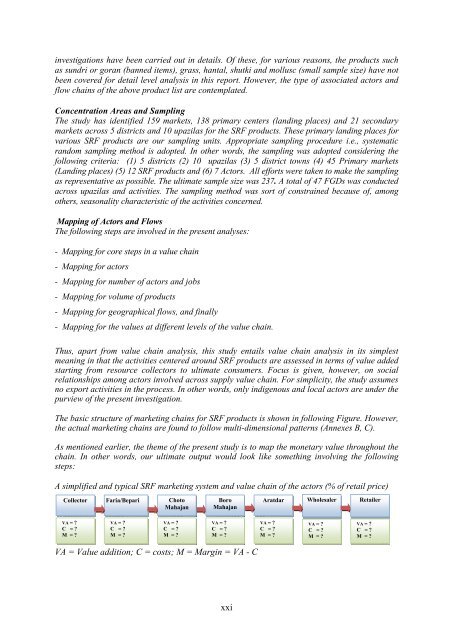INTEGRATED PROTECTED AREA CO-MANAGEMENT (IPAC) - BIDS
INTEGRATED PROTECTED AREA CO-MANAGEMENT (IPAC) - BIDS
INTEGRATED PROTECTED AREA CO-MANAGEMENT (IPAC) - BIDS
You also want an ePaper? Increase the reach of your titles
YUMPU automatically turns print PDFs into web optimized ePapers that Google loves.
investigations have been carried out in details. Of these, for various reasons, the products such<br />
as sundri or goran (banned items), grass, hantal, shutki and mollusc (small sample size) have not<br />
been covered for detail level analysis in this report. However, the type of associated actors and<br />
flow chains of the above product list are contemplated.<br />
Concentration Areas and Sampling<br />
The study has identified 159 markets, 138 primary centers (landing places) and 21 secondary<br />
markets across 5 districts and 10 upazilas for the SRF products. These primary landing places for<br />
various SRF products are our sampling units. Appropriate sampling procedure i.e., systematic<br />
random sampling method is adopted. In other words, the sampling was adopted considering the<br />
following criteria: (1) 5 districts (2) 10 upazilas (3) 5 district towns (4) 45 Primary markets<br />
(Landing places) (5) 12 SRF products and (6) 7 Actors. All efforts were taken to make the sampling<br />
as representative as possible. The ultimate sample size was 237. A total of 47 FGDs was conducted<br />
across upazilas and activities. The sampling method was sort of constrained because of, among<br />
others, seasonality characteristic of the activities concerned.<br />
Mapping of Actors and Flows<br />
The following steps are involved in the present analyses:<br />
- Mapping for core steps in a value chain<br />
- Mapping for actors<br />
- Mapping for number of actors and jobs<br />
- Mapping for volume of products<br />
- Mapping for geographical flows, and finally<br />
- Mapping for the values at different levels of the value chain.<br />
Thus, apart from value chain analysis, this study entails value chain analysis in its simplest<br />
meaning in that the activities centered around SRF products are assessed in terms of value added<br />
starting from resource collectors to ultimate consumers. Focus is given, however, on social<br />
relationships among actors involved across supply value chain. For simplicity, the study assumes<br />
no export activities in the process. In other words, only indigenous and local actors are under the<br />
purview of the present investigation.<br />
The basic structure of marketing chains for SRF products is shown in following Figure. However,<br />
the actual marketing chains are found to follow multi-dimensional patterns (Annexes B, C).<br />
As mentioned earlier, the theme of the present study is to map the monetary value throughout the<br />
chain. In other words, our ultimate output would look like something involving the following<br />
steps:<br />
A simplified and typical SRF marketing system and value chain of the actors (% of retail price)<br />
Collector Faria/Bepari Choto<br />
Boro<br />
Aratdar Wholesaler<br />
Mahajan Mahajan<br />
Retailer<br />
VA = ?<br />
C = ?<br />
M = ?<br />
VA = ?<br />
C = ?<br />
M = ?<br />
VA = ?<br />
C = ?<br />
M = ?<br />
VA = ?<br />
C = ?<br />
M = ?<br />
VA = ?<br />
C = ?<br />
M = ?<br />
VA = ?<br />
C = ?<br />
M = ?<br />
VA = ?<br />
C = ?<br />
M = ?<br />
VA = Value addition; C = costs; M = Margin = VA - C<br />
xxi














